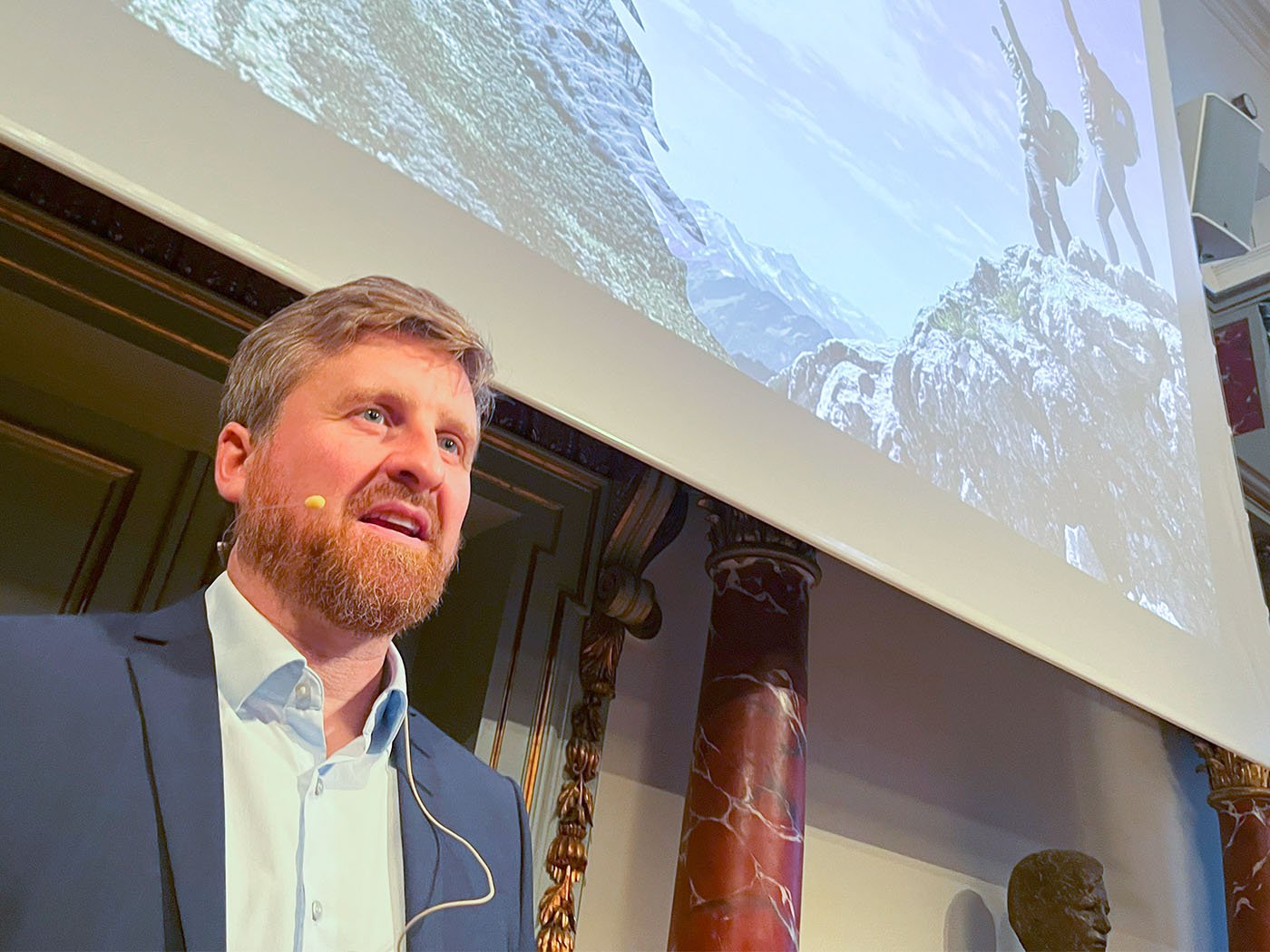One of the most important tasks of the manager is to motivate, retain and develop the employees. The team should possess the competencies required to provide the requested solutions, products or services. As markets change, expectations change, or the organisation moves in a different direction, the team needs to be equipped to meet these changes.
Part of this competence adjustment is closely linked to the daily dialogue between manager and employee. A direction must be set for the employee's work. Knowledge and visions for the future must be shared. And words must be put to the current competencies and desired development.
The dialogues basically help create joint development, motivation and well-being among the employees. In this blog post, we address some of the most important dialogues that are supported by Evovia's digital tools.
Clarification and development of competences
We recommend that a 'Competence web' is made for each employee in connection with the EDP interview. First, a questionnaire is designed that contains all the necessary competences in the various teams. Based on this questionnaire, the employee and the manager then assess the competences of the employee. Not with a view to ”measuring” or ”scoring” the employee. On the contrary. The questionnaire should facilitate a dialogue about areas with a potential for development.
If the manager becomes aware that important competencies are lacking in the team, and one of the employees wishes to cover this gap by developing their skills – for example, by taking a course – the manager can use the module 'Competence Development'. In this case, the manager and the employee can discuss expectations, experiences and yield, before, during and after the course takes place. This helps ensure that the employee keeps an eye on the expected yield during the course. It also ensures that knowledge about important courses is stored in the organisation. If it turns out that a course is far from living up to expectations, you might not want to send another employee on the same course, the next time the skill gap occurs.
It may also be a good idea to get employees throughout the organisation to fill out their resumés in Evovia. This makes it possible for the manager or HR to search for specific competencies, courses, educational backgrounds etc. If a vacancy or a skill gap should appear, the competencies may already exist elsewhere in the organisation. If the employees keep their resumes updated, it is easy to search through them in Evovia.
One solution to the demand for new competencies could also be to hire a brand-new employee in the team. This solution launches a process of role and competence clarification. Exactly what type of employee is needed? Once again, the competence web may come to the rescue, as it makes it possible to compare answers across teams and departments, so the manager can see what competencies are particularly needed. Parallel to this, it is a good idea to design an onboarding process.
Onboarding: Give your new employees a good welcome
You have decided that a new employee is needed in your team. What should the new employee learn during the first weeks? Are there any programs or systems that are important to be introduced to from the start? Perhaps you have a policy that there is a flower on the new employee's desk on the first working day. Write down all thoughts and practical tasks.
In Evovia we work with two tracks in the onboarding module: a checklist and a dialogue process. The checklist is a "to-do list" for the employees of the organisation. Who buys the flower? What tools should be ordered? Etc. But it is also the new employee's checklist. Has Rikke gained access to the intranet?
The dialogue process is a series of dialogues under a fixed structure. It may be planned so that you talk with your immediate manager on the first day, after the first week, first month etc. In this process, the manager gets a good feel of whether everything is as it should be throughout the start-up phase. And it is great for retaining the employee.
Studies show that the first six months of the onboarding process are the most critical. You can read more about this in our blog post 'Help your employees climb Mt. Onboarding'
Employee and team development
It is a good idea to have employee development interviews with employees once a year or more. At the EDP interview, you get to break down the objectives of the organisation and you set a direction for the individual. This is also the place where professional relations are built, and well-being and retention are ensured. In principle, an EDP interview should be "open" throughout the year, and therefore it is important to follow up, comply with agreements and ensure that the agreed objectives are achieved. You can read more about this in our blog post 'Make the EDP interview last all year'.
Team development dialogues (TDP) may be a useful complement to the employee development interviews because you have the opportunity to work purposefully as a group. TDP can be used to address many different themes, but overall it is a way to work with the group's development as a whole.
Workplace assessment: ”Does it hurt here?”
All companies with employees need to perform a written workplace assessment (WPA) to be renewed every three years. The WPA must be prepared jointly by the employer, and the working environment organisation or the employees. We look at the WPA as a sort of ”medical check” for the work environment: ”Does it hurt here?”, ”What about here?”. If the answer is ”No”, that is a positive thing. Work needs to be done in the places where it hurts. Therefore, it is important to ask the right questions that focus on the sore points.
In Evovia, you can design your own questionnaire, so the WPA focuses on the areas that are important in your organisation. At the same time, the system invites to a dialogue about the problems, and it is possible to make concrete agreements directly in the minutes that fit the action plans made based on the results.
Early and ongoing dialogue on sick leave
If you're sick, you're sick. But sometimes, regular illness may signal other problems. In some organisations, there may even be problems with high sick leave statistics or employees that are stressed or otherwise put under pressure. In Evovia we have, in cooperation with our customer for several years – Sønderborg Municipality – developed a sick leave module with a focus on dialogue.
The employee is reported sick on the first day of absence, and then a dialogue process is activated, that is set up to suit your organisation. Our default settings suggest a dialogue on day 1, day 5, day 14 and day 28. In addition, there are minute sheets for additional dialogues, where notes can always be added, and agreements made outside the planned dialogues.
The system suggests that you talk to the employee about how he or she is doing, whether there are any tasks that need to be handed over to a co-worker, etc. The whole point of the dialogues is to put words to any problems early in the process so that they can be addressed. At the same time, it sends a signal to the employee that the manager takes the employee's disease seriously and helps them to get through the course of the disease.
360-degree leadership evaluation
As is the case for employees, managers can also benefit from focusing on their own development. Naturally, a manager has employment development interviews with his or her own boss, but if the organization wants to get an overall overview of management culture in the organisation, it may be a good idea to make management evaluations.
We recommend doing 360 degrees manager evaluations at all management levels to get the best overview. 360 degrees means that the manager is assessed from all sides: from above (the manager's own boss), from the side (management colleagues at the same level), from below (the employees for which the manager is responsible) as well as from internal and external partners.
Based on the evaluations, it is possible to compile statistics for each department, thereby getting a picture of the culture in all the different corners of the organisation. Based on the statistics, it is important to follow up with dialogues and concrete action plans to ensure the best development.
Offboarding: Say goodbye to an employee
It is not just important to welcome new employees. It is also important to say a proper goodbye to those who leave the organisation. This applies both to those who choose to look for new places themselves, and to those who, for some reason or another, have to be dismissed from the organisation.
By saying a proper goodbye, you ensure that your company gets the most knowledge and experience from the process. In Evovia, it is possible to set up an offboarding process with a questionnaire that allows the employee to pass on his or her knowledge of the organisation. How did the employee experience the company? And is it anything the company can work on to improve?
Read our blog post on offboarding 'Help employees move on and stop losing important knowledge'.



